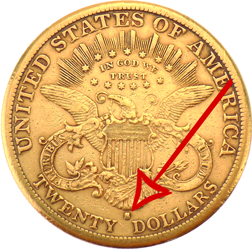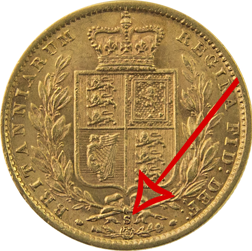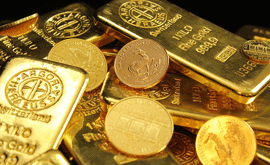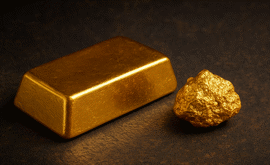What are the Mint Marks on Coins?
What is a mint mark?
A mint mark is a letter, letters, or symbol indicating the mint where a coin was produced. While additional marks, such as mint master and assayer marks, may offer variations that hint at a coin's origin, the mint mark represents the true institution where the coin was created.
Mint marks were first created to identify any issues with a coin. If a coin was underweight or overweight, the mint mark would tell you where the coin was minted, and the problem could then be found and fixed from its source.
History of mint marks
The first mint marks, known as “magistrates marks”, were created by the Greeks who named a magistrate to be in charge of producing that coin. Debasing or tampering with a coin was a very serious offence, sometimes punishable by death in some civilisations. In 1649, the directors of the Spanish Colonial American Mint at Potosi (now known as Bolivia) were sentenced to death for debasing coinage. The coins displayed the initials of the assayer and the mint mark to identify when and where the coins were inspected.
In the 19th century, numismatists didn’t collect coins based on their mint mark, instead opting to obtain the date sets of coins. This changed in 1893 when A.G. Heaton’s "A Treatise on Coinage of the United States Branch Mints" was published. In this book, Heaton cited examples of mint-marked coins that were much more rare than Philadelphia products, highlighting that they should bring high premiums.
When the USA abandoned silver coins in 1965, they removed mint marks from the new copper-nickel coins as they believed it would stop the removal of coins from circulation by collectors. The opposite happened as silver coins then disappeared quickly from circulation and there were fears that a shortage of coinage would happen if it continued. They put mint marks back on US coins in 1967.
The importance of mint marks for coin collectors
Certain collectors interested in numismatic coins also take an interest in mint marks. Occasionally, a mint mark can significantly impact the value of a coin, making some mint-marked coins more collectable. In fact, a rare mint mark has been known to add thousands to a coin's value. Understanding the exact location of where a coin was minted can also add an intriguing dimension to coin collecting.
Different types of British mint marks on coins
The Royal Mint has been responsible for minting coins in the UK since its beginnings as the London Mint back in 886 AD. After operating from London until the 1960s, The Royal Mint is now based in Llantrisant in South Wales. In the past, there were many other mints in towns across the UK and the Medieval mints often used pictures or small symbols to represent the mint the coin comes from.
The defining factor of The Royal Mint is that it rarely uses a mint mark for British coins. The sovereigns minted in the UK feature no mint mark, whereas sovereigns created at branch mints overseas feature unique lettering to represent the mint where it has been produced. For example, the letter 'S' represents the Sydney mint, Melbourne 'M', Perth 'P', and Ottawa 'C'.
London and Llantrisant: 1817–1917, 1925, 1957–2018
Gold Sovereigns were mostly made in London, with production lasting from 1817 to 1917. During the First World War, the sovereign was replaced with paper money due to a run on gold through public fear. The gold coins were still produced to a lesser degree and kept in Britain’s gold reserves - which were then used to pay war debts to the United States.
The sovereign coin briefly returned in 1925 through the Gold Standard Act, but didn’t last long. The Royal Mint didn’t produce gold sovereigns again until 1953 for Queen Elizabeth II’s coronation, but this was only for museum pieces.
Demand for gold sovereigns increased in the Middle East in 1957, so The Royal Mint started producing the coin once more. Production then moved to South Wales during the mid-1970s.
Australia: 1855–1931 (S, P, and M)
It was the discovery of gold in Australia that led to the country being involved with the minting of British gold sovereigns. This discovery made it very cost effective as there was then no need to shift the gold to the UK. Before the Australian mints adopted the St George and Dragon design in 1887, coins produced in Australia featured their own local designs.
India: 1918 (I)
The Royal Mint opened a mint in Bombay (now Mumbai) in 1918. The refinery only produced coins for a year, and they all had the mint mark initial 'I' for India. In that time, they made 1.3 million coins featuring the image of George V.
Canada: 1908–1919 (C)
The Ottawa Mint used gold mines in British Columbia and Yukon to create its sovereigns. It opened in 1908 and produced coins until 1919, but it only made 628,152 in that time.
The Royal Mint also used the Ottawa plant to smelt down the coins of Britain’s gold reserves. These were made into gold bullion bars for the US government to pay off First World War debts.
The Ottawa mint became the Royal Canadian Mint in 1931, and it is still based in the same castle-like headquarters today.
South Africa: 1923–1932 (SA)
Britain opened a Royal Mint branch in South Africa after the resolution of the Boer War. The gold sovereign was no longer in circulation as UK currency, but it was still used overseas.
1923 was a test year for the mint where only 423 coins were minted, but by the end of the nine-year production run, 83.4 million sovereigns were produced. In 1941, the branch separated from The Royal Mint to become the South African Mint.
If you are looking to buy and sell coins featuring mint marks, Atkinsons Bullion is the best place to do so. Find gold sovereigns from mints across the world to buy here, or we can also give you a fair valuation of your collection if you are looking to sell to us. For more information, get in touch with us today.
This blog represents one person’s opinion only. Please note, gold and silver prices may go down as well as up. Atkinsons Bullion & Coins accepts no responsibility for any losses based on information we have provided. We do not offer investment advice. Please carry out your own research before making an investment decision.
















